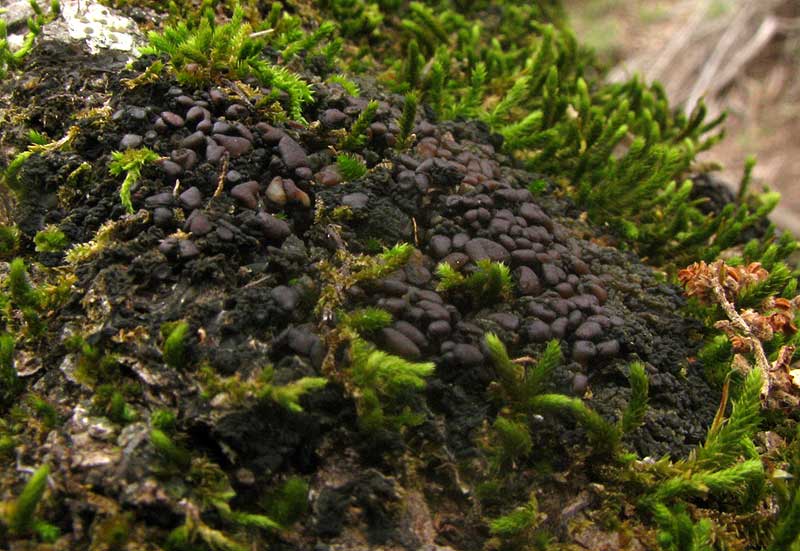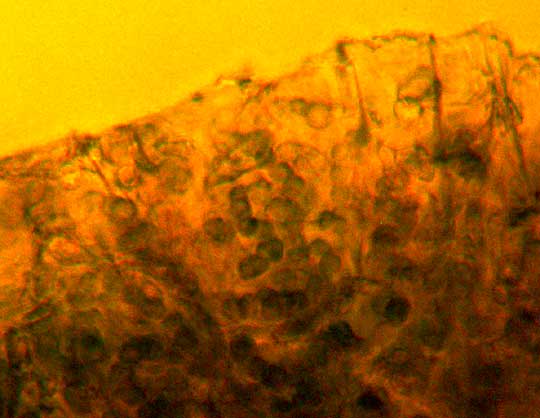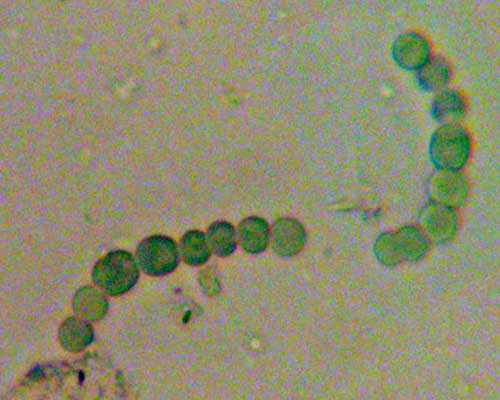Excerpts from Jim Conrad's
Naturalist Newsletter

from the June 29, 2014 Newsletter issued from the Frio Canyon Nature Education Center in the valley of the Dry Frio River in northern Uvalde County, southwestern Texas, on the southern border of the Edwards Plateau; elevation ~1750m (~5750 ft); N29.62°, W99.86°; USA
JELLY LICHEN
This February when the lack of insects and flowering plants set me to looking at the area's lichens and mosses, I came upon an eye-catching colony of Common Thelia Moss forming a green patch on a liveoak trunk leaning across a shaded arroyo, or usually dry stream. At that time I wondered why such a healthy looking moss population might colonize that particular tree trunk but not others in the area. You can see the patch of Thelia Moss as it appeared in February at https://www.backyardnature.net/n/x/thelia.htm.
This week I visited the same patch of moss. It was still thriving but now amidst its branching, bark-hugging stems a blackish, warty-looking mass had established itself. My first impression was that the moss colony had developed a disease. You can see the situation at the top of this page. A close-up of a transition zone between green moss stems and "black blight" appears below:

That picture shows that the "blight" begins as a kind of wrinkled jelly that gives way to somewhat flattened little brown balls, and that the balls have some kind of rim surrounding their flattish heads. The balls look like some kind of very tiny, earthball-like mushroom.
The balls' color and the gelatinous nature of other parts of the "blight" inspired me to begin the identification process by searching on the Internet for species of cyanobacteria that might cohabit with mosses. Cyanobacteria came to mind because commonly seen on undisturbed soil around here is a form of gelatinous cyanobacterium sometimes called Witches Butter -- genus Nostoc -- which we've profiled at https://www.backyardnature.net/n/x/nostoc.htm.
Doing an image search on the keywords "cyanobacterium mosses," soon an image turned up from a website in England showing almost the same thing as our pictures do. It identified the gelatinous "blight" as the genus Collema, the species of which are commonly known as jelly lichens, of the lichen family Collemataceae.
Keeping in mind that lichens are composite organisms composed of photosynthesizing algal and/or cyanobacteria cells enmeshed in fungal hyphae, and that lichen technical names, or binomials, are based on the fungal species, Collema is the name of the fungus in which the photosynthesizing cells are enmeshed. Moreover, the literature tells us that the fungus Collema forms lichens with the cyanobacteria called Nostoc. It's not the same Nostoc species as our Witches Butter but another one.
Learning that the jelly-like part of the lichen is provided by a Nostoc species, I recalled that we have microscopic views of our Witches Butter species, shown on our Nostoc page. Therefore, now I put some of our "blight" jelly below our microscope, and below you can see greenish, spherical cells suspended in that gelatinous material:

Some beads of what I assume to be photosynthetic Nostoc cells teased from their jelly matrix are shown below:

Just by matching pictures, it looks like to me that our "blight" is the jelly lichen COLLEMA POLYCARPON, known to be found in our area and to often be associated with mosses. However, literature states that it grows on rock, while ours was on a tree. I'm unsure what the deal is, but I'm filing this page on the Internet under the name Collema polycarpon in the hope that someday an expert will clarify the situation.
Meanwhile I am just basking in having discovered a whole new form of life, that of the "jelly lichen." Moreover, I'm happy to know that your blackish jelly wasn't a blight, but rather the cyanobacterium Nostoc, which is known not only to supply photosynthesized food to its fungal partner, but also it fixes nitrogen, which well may explain why last February our tree-trunk colony of Common Thelia Moss was doing so well in such a seemingly exposed habitat.